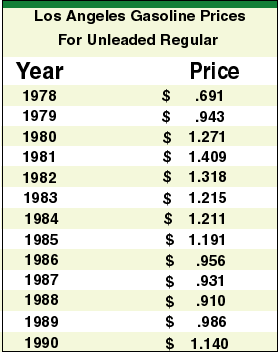Bar Graphs help to make comparisons among several items in a given
category. To make a bar graph, follow these steps below.
 Draw two perpendicular axes on grid paper. Label each axes to
identify the variables. Draw two perpendicular axes on grid paper. Label each axes to
identify the variables.
 Choose a scale that will permit the full range of values to be graphed. Mark one axis with
equal intervals.
Choose a scale that will permit the full range of values to be graphed. Mark one axis with
equal intervals.
 Mark
the other axis with equal intervals. These intervals do not have to match those used on
the other axis. Mark
the other axis with equal intervals. These intervals do not have to match those used on
the other axis.
 Using the data values, carefully find the height of each bar for each item. Draw and shade
each bar. Be sure to leave space between your bars.
Using the data values, carefully find the height of each bar for each item. Draw and shade
each bar. Be sure to leave space between your bars.
4. Study the bar graph shown below.

a. What is being compared in this bar graph?
b. What conclusions can you make from the data show by the bar graph?
5. Refer to your data from your class
questionnaire survey on page 24 of your Portfolio Builder. Use the data from one
question to make a bar graph.
Line graphs are used to show the behavior of a variable.
To make a line graph, follow the steps below.
 Draw two axes on grid paper as described before. The horizontal axis usually shows units
of time, and the vertical axis represents the quantity being studied.
Draw two axes on grid paper as described before. The horizontal axis usually shows units
of time, and the vertical axis represents the quantity being studied.
 Graph the points for the data
and then connect the points from left to right with line segments. Graph the points for the data
and then connect the points from left to right with line segments.

6. With your partner, study and
discuss the following data.
a. Make a line graph of the data.
b. What is the year with the highest annual gasoline?
c. What is the greatest difference when comparing consecutive years? Why
might it be different each month?
d. How can you use the graph to find the median? the mode? the mean? the
range?
e. What is the overall pattern?

Using the information from the chart, make a
scatter plot using the data from the two different columns in the solar system chart. Here
are some ideas for scatter plots.
 planet diameter and distance from the sun planet diameter and distance from the sun
 planet diameter and number of moons
planet diameter and number of moons
 planet diameter and time for one rotation
planet diameter and time for one rotation
 planet diameter and time for one orbit
planet diameter and time for one orbit
 distance from the sun and number of moons
distance from the sun and number of moons
 distance from the sun and time for one orbit
distance from the sun and time for one orbit
 distance from the sun and time for one rotation
distance from the sun and time for one rotation
 number of moons and time for one orbit
number of moons and time for one orbit
 number of moons and time for one rotation
number of moons and time for one rotation
 time
for one rotation and time for one orbit time
for one rotation and time for one orbit
a. Are there any patterns suggested by
your scatter plot?
b. Compare and discuss your results with other students. What are the
most interesting relationships found? Why?
8. The table shows the
winning times (in minutes) for the men's Olympic marathon from 1896 to 1988. The times are
rounded to the nearest minute.
a. Construct an appropriate graph for
this data.
b. Find the three dates when there is no data. Why are these dates
missing?
c. When did the greatest improvement in the winning time occur? Why do
you think this is true?
d. What do you predict for the winning time in 1996? 2000? 2020?
9. Using newspapers, collect one
example of each kind of graph you have learned about. Mount the graph on a sheet of paper.
Note the type of graph and it's source. Write a brief explanation of any conclusions you
found from the graph. |



